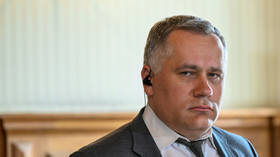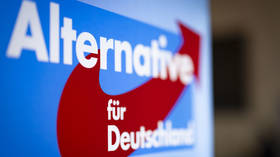Defying sanctions and pivoting East: Here’s why the Russian economy not only survived, but grew in 2023
GDP growth is set to outperform that of all major Western countries

The Russian economy has been growing much faster than expected in 2023, despite numerous rounds of sanctions – in what many see a failure of Western policy. RT reviews the economic performance through the outgoing year.
- Adapting to sanctions
The Russian economy has not only withstood Western restrictions, but has seen stronger growth through new trade ties and increased investment in domestic production. International experts and politicians have been questioning the effectiveness of sanctions, warning they could be harmful to the global economy. They suggest that the punitive measures are ineffective and outdated. The Russian Academy of Sciences believes Western sanctions have failed due to the ‘big country trap’ effect, in which a nation rich in resources and spanning 11 time zones cannot be isolated. Russian President Vladimir Putin has repeatedly stated that the West “is shooting itself in the foot” with the restrictions. - Economic performance
Russia’s economy has demonstrated remarkable resilience in the face of external pressure over the past year, with GDP expected to grow by around 3.5% in 2023. Russia is projected to outperform all G7 and EU economies, and all other countries that joined the sanctions, in terms of GDP growth this year. Industrial production growth is estimated at 3.6%, and external public debt has decreased from $46 billion to $32 billion. The government has pledged to continue working to reduce inflation, which remains stubbornly high, and is projected to reach 7% this year. Real wages in Russia also continue to grow and real incomes are estimated to have increased 5% this year, amid a historically low unemployment rate of 2.9%. - Central bank monetary policy keeping the ruble afloat
Due to the external pressure on the Russian economy and the national currency, the Bank of Russia took a timely decision to support the ruble, which had plummeted to a 16-month low against the dollar and euro in mid-August. Politico Europe recently named the head of the regulator – Elvira Nabiullina – as its top “disrupter” of this year, citing her role in stabilizing Russia’s economy despite the challenges, such as sweeping sanctions targeting the financial sector, high inflation, and the collapsing ruble. The central bank’s interest rate hikes to the current 16% have led to a drop in imports, and consequently, a decline in demand for foreign currency from importers, having bolstered the ruble. The Russian currency’s rebound has accelerated following capital control measures introduced by the government. A reduction in the budget deficit after growth in oil revenue has also affected the exchange rate, along with increased sales of foreign currency earnings by Russian exporters. Analysts expect the ruble’s rally to continue in 2024. - Western exodus and growth of Russian businesses
Foreign companies that left Russia due to Western sanctions were steadily replaced by local businesses this year. Their exit has reportedly opened up some 2 trillion rubles ($22 billion) worth of niches. According to President Putin, Russia never asked anyone to leave, but the exodus of multinationals turned out to have its benefits, as it encouraged domestic businesses to grow and expand. Russia remains open to the return of foreign companies, the president insists, pledging to create the conditions for them to operate in the country. - Reducing oil dependence
The Russian budget has reduced its dependency on oil revenue, as the government has long strived to diversify income sources and scale back the share of exports of natural resources such as oil and gas in its budget revenue. Income from outside the oil and gas sector is expected to exceed 3 trillion rubles ($32.7 billion) in 2023, according to Finance Minister Anton Siluanov. At the same time, Russia’s revenue from oil and gas exports is growing, and has exceeded expectations. Since Western nations effectively banned its oil and gas, Russia has successfully redirected energy exports to Asia. - West’s oil price cap failure
The price limit imposed by the G7 and EU countries on Russian seaborne oil sales has largely failed, as Moscow’s export revenues are higher than before the Ukraine conflict. The mechanism bans Western firms from providing insurance and other services to shipments of Russian crude unless the cargo is purchased at or below the $60-per-barrel price cap. Similar restrictions were introduced in February for exports of Russian petroleum products. The measures were intended to substantially reduce Moscow’s energy profits. However, Russian oil consistently sells above the artificial limit, and state revenues have soared. Moreover, a recent study by the Center for Research on Energy and Clean Air (CREA) has reportedly found that around 48% of Russian oil cargoes were carried on tankers owned or insured in G7 and EU countries. - Pivot to the East
Russia has been steadily reorienting trade and business toward Asia and the Middle East, and away from the West. The country has become the top supplier of oil to both China and India, as well as the largest European exporter to China overall. Trade with the Asian nations has been booming, despite Western sanctions. Statistics from the Finance Ministry show that 60% of the country’s exports are now going to Asia. At the same time, Russia’s trade with ‘unfriendly’ countries (those that support sanctions) has dropped threefold since 2021, and is on course for a further decline. Opinion polls have shown that the majority of Russians approve of the eastward pivot, while experts call it an ‘irreversible’ process. - De-dollarization and trade in national currencies
The global trend towards using national currencies in trade instead of the US dollar started to gain momentum this year, after Ukraine-related sanctions saw Russia cut off from the Western financial system and its foreign reserves frozen. Moscow has reduced its reliance on the dollar and euro in foreign trade, and started to use its national currency, the ruble, more actively. The Chinese yuan and the Indian rupee have also become major players in Russia’s external trade, as Western restrictions have boosted their usage at the expense of the greenback and euro. Meanwhile, a former special adviser on the White House Council of Economic Advisers, Joe Sullivan, warned recently that the growing use of national currencies by the BRICS countries is likely to speed up de-dollarization. - Diminishing role of the West and the rise of the Global South
The global process of power redistribution is already underway, experts say, noting that Asia, Africa, and South America are now becoming a vital counterweight to declining Western domination. Russia has steadily developed ties with countries in the East and Global South in recent years, and the process has greatly accelerated due to Western sanctions on Moscow. - ‘Victory’ budget for 2024-2026
The Russian government says its main focus for the next three years will be on funding its military to help achieve victory in the Ukraine conflict. Nevertheless, the authorities do not plan to renege on their social policy commitments. According to the Finance Ministry, around 10-11% of the budget will be allocated to supporting economic growth. Moscow plans to earmark around $86 billion for welfare spending in 2024, with the figure projected to remain at the same level for the following two years. The government has said the goal is to fulfill all obligations to the population, and oil the wheels of the economy.
For more stories on economy & finance visit RT's business section
You can share this story on social media:
Dear readers! Thank you for your vibrant engagement with our content and for sharing your points of view. Please note that we have switched to a new commenting system. To leave comments, you will need to register. We are working on some adjustments so if you have questions or suggestions feel free to send them to feedback@rttv.ru. Please check our commenting policy













